hood open Hyundai Genesis Coupe 2015 Owner's Manual
[x] Cancel search | Manufacturer: HYUNDAI, Model Year: 2015, Model line: Genesis Coupe, Model: Hyundai Genesis Coupe 2015Pages: 438, PDF Size: 40.35 MB
Page 98 of 438
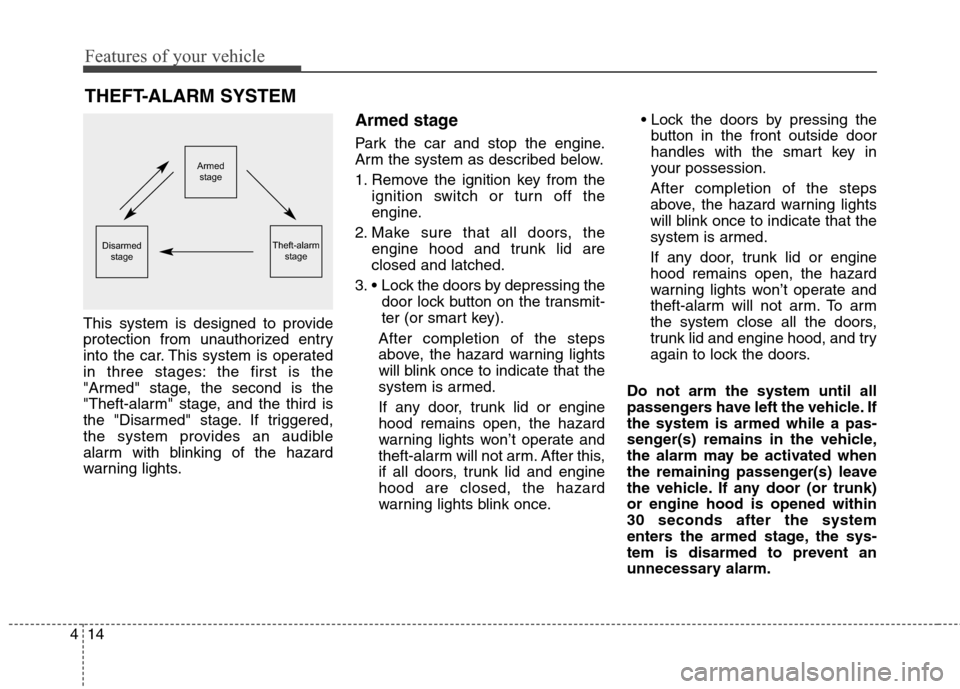
Features of your vehicle
14 4
This system is designed to provide
protection from unauthorized entry
into the car. This system is operated
in three stages: the first is the
"Armed" stage, the second is the
"Theft-alarm" stage, and the third is
the "Disarmed" stage. If triggered,
the system provides an audible
alarm with blinking of the hazard
warning lights.
Armed stage
Park the car and stop the engine.
Arm the system as described below.
1. Remove the ignition key from the
ignition switch or turn off the
engine.
2. Make sure that all doors, the
engine hood and trunk lid are
closed and latched.
3.
door lock button on the transmit-
ter (or smart key).
After completion of the steps
above, the hazard warning lights
will blink once to indicate that the
system is armed.
If any door, trunk lid or engine
hood remains open, the hazard
warning lights won’t operate and
theft-alarm will not arm. After this,
if all doors, trunk lid and engine
hood are closed, the hazard
warning lights blink once.
button in the front outside door
handles with the smart key in
your possession.
After completion of the steps
above, the hazard warning lights
will blink once to indicate that the
system is armed.
If any door, trunk lid or engine
hood remains open, the hazard
warning lights won’t operate and
theft-alarm will not arm. To arm
the system close all the doors,
trunk lid and engine hood, and try
again to lock the doors.
Do not arm the system until all
passengers have left the vehicle. If
the system is armed while a pas-
senger(s) remains in the vehicle,
the alarm may be activated when
the remaining passenger(s) leave
the vehicle. If any door (or trunk)
or engine hood is opened within
30 seconds after the system
enters the armed stage, the sys-
tem is disarmed to prevent an
unnecessary alarm.
THEFT-ALARM SYSTEM
Armed
stage
Theft-alarm
stageDisarmed
stage
Page 99 of 438
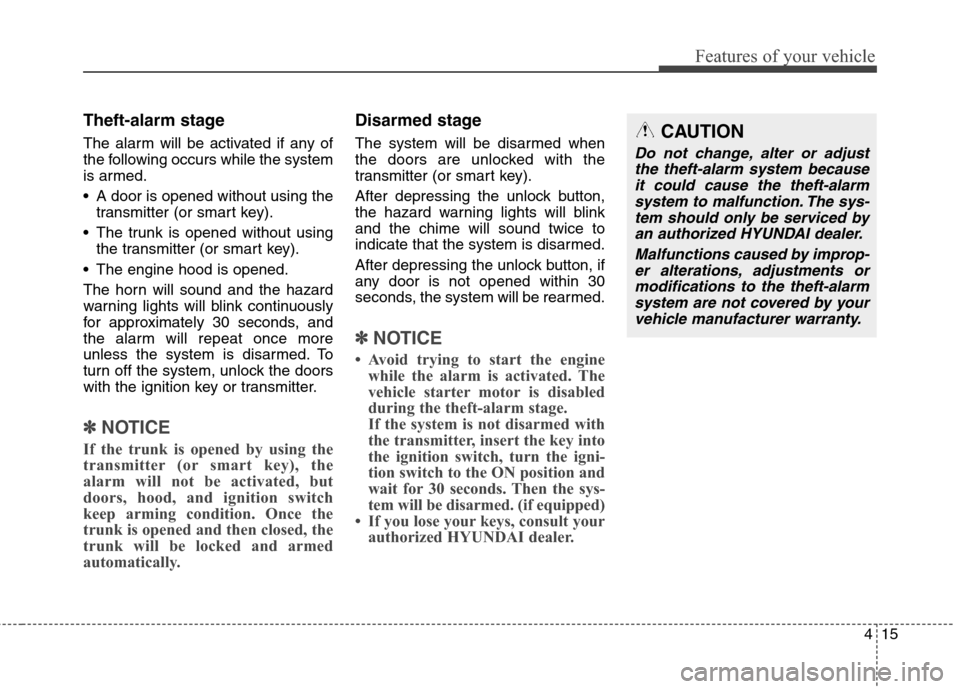
415
Features of your vehicle
Theft-alarm stage
The alarm will be activated if any of
the following occurs while the system
is armed.
A door is opened without using the
transmitter (or smart key).
The trunk is opened without using
the transmitter (or smart key).
The engine hood is opened.
The horn will sound and the hazard
warning lights will blink continuously
for approximately 30 seconds, and
the alarm will repeat once more
unless the system is disarmed. To
turn off the system, unlock the doors
with the ignition key or transmitter.
✽ ✽
NOTICE
If the trunk is opened by using the
transmitter (or smart key), the
alarm will not be activated, but
doors, hood, and ignition switch
keep arming condition. Once the
trunk is opened and then closed, the
trunk will be locked and armed
automatically.
Disarmed stage
The system will be disarmed when
the doors are unlocked with the
transmitter (or smart key).
After depressing the unlock button,
the hazard warning lights will blink
and the chime will sound twice to
indicate that the system is disarmed.
After depressing the unlock button, if
any door is not opened within 30
seconds, the system will be rearmed.
✽ ✽
NOTICE
• Avoid trying to start the engine
while the alarm is activated. The
vehicle starter motor is disabled
during the theft-alarm stage.
If the system is not disarmed with
the transmitter, insert the key into
the ignition switch, turn the igni-
tion switch to the ON position and
wait for 30 seconds. Then the sys-
tem will be disarmed. (if equipped)
• If you lose your keys, consult your
authorized HYUNDAI dealer.
CAUTION
Do not change, alter or adjust
the theft-alarm system because
it could cause the theft-alarm
system to malfunction. The sys-
tem should only be serviced by
an authorized HYUNDAI dealer.
Malfunctions caused by improp-
er alterations, adjustments or
modifications to the theft-alarm
system are not covered by your
vehicle manufacturer warranty.
Page 110 of 438
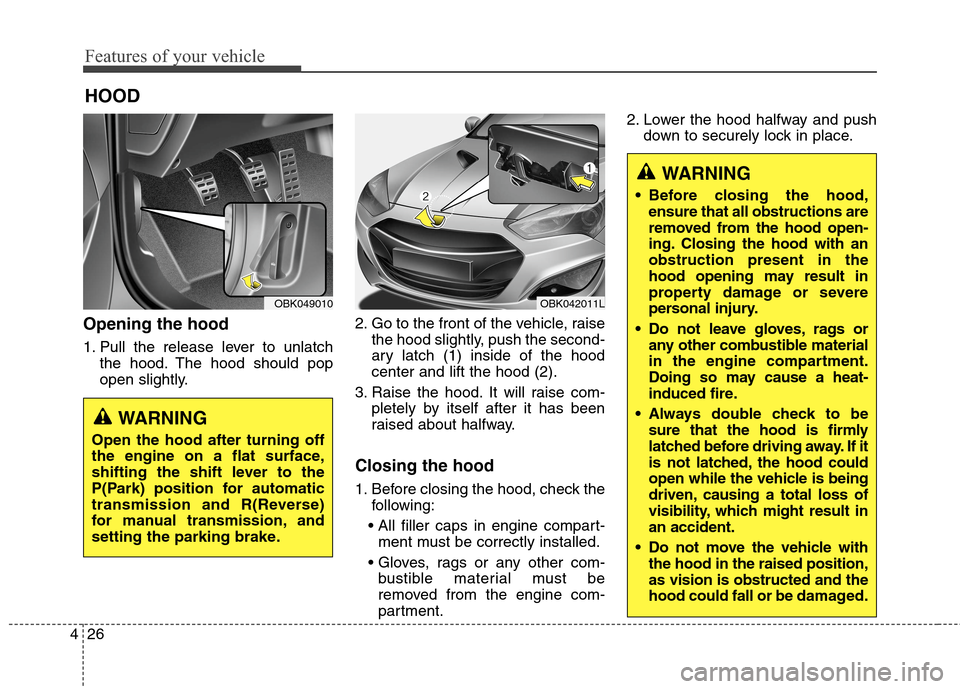
Features of your vehicle
26 4
Opening the hood
1. Pull the release lever to unlatch
the hood. The hood should pop
open slightly.2. Go to the front of the vehicle, raise
the hood slightly, push the second-
ary latch (1) inside of the hood
center and lift the hood (2).
3. Raise the hood. It will raise com-
pletely by itself after it has been
raised about halfway.
Closing the hood
1. Before closing the hood, check the
following:
ment must be correctly installed.
bustible material must be
removed from the engine com-
partment.2. Lower the hood halfway and push
down to securely lock in place.
HOOD
WARNING
Before closing the hood,
ensure that all obstructions are
removed from the hood open-
ing. Closing the hood with an
obstruction present in the
hood opening may result in
property damage or severe
personal injury.
Do not leave gloves, rags or
any other combustible material
in the engine compartment.
Doing so may cause a heat-
induced fire.
Always double check to be
sure that the hood is firmly
latched before driving away. If it
is not latched, the hood could
open while the vehicle is being
driven, causing a total loss of
visibility, which might result in
an accident.
Do not move the vehicle with
the hood in the raised position,
as vision is obstructed and the
hood could fall or be damaged.
OBK049010OBK042011L
WARNING
Open the hood after turning off
the engine on a flat surface,
shifting the shift lever to the
P(Park) position for automatic
transmission and R(Reverse)
for manual transmission, and
setting the parking brake.
Page 314 of 438
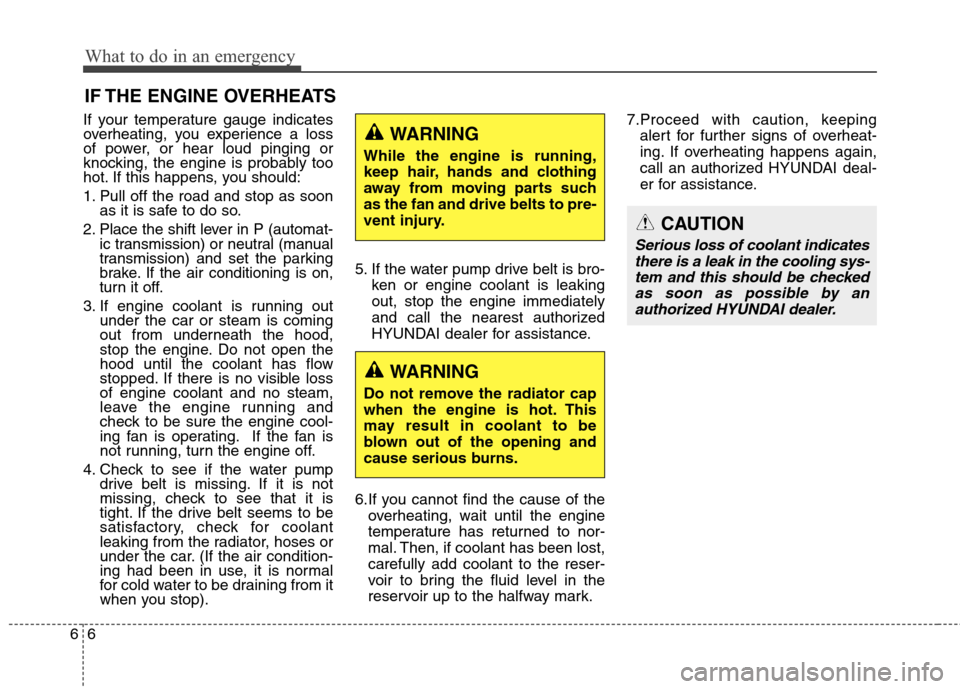
What to do in an emergency
6 6
IF THE ENGINE OVERHEATS
If your temperature gauge indicates
overheating, you experience a loss
of power, or hear loud pinging or
knocking, the engine is probably too
hot. If this happens, you should:
1. Pull off the road and stop as soon
as it is safe to do so.
2. Place the shift lever in P (automat-
ic transmission) or neutral (manual
transmission) and set the parking
brake. If the air conditioning is on,
turn it off.
3. If engine coolant is running out
under the car or steam is coming
out from underneath the hood,
stop the engine. Do not open the
hood until the coolant has flow
stopped. If there is no visible loss
of engine coolant and no steam,
leave the engine running and
check to be sure the engine cool-
ing fan is operating. If the fan is
not running, turn the engine off.
4. Check to see if the water pump
drive belt is missing. If it is not
missing, check to see that it is
tight. If the drive belt seems to be
satisfactory, check for coolant
leaking from the radiator, hoses or
under the car. (If the air condition-
ing had been in use, it is normal
for cold water to be draining from it
when you stop).5. If the water pump drive belt is bro-
ken or engine coolant is leaking
out, stop the engine immediately
and call the nearest authorized
HYUNDAI dealer for assistance.
6.If you cannot find the cause of the
overheating, wait until the engine
temperature has returned to nor-
mal. Then, if coolant has been lost,
carefully add coolant to the reser-
voir to bring the fluid level in the
reservoir up to the halfway mark.7.Proceed with caution, keeping
alert for further signs of overheat-
ing. If overheating happens again,
call an authorized HYUNDAI deal-
er for assistance.
WARNING
While the engine is running,
keep hair, hands and clothing
away from moving parts such
as the fan and drive belts to pre-
vent injury.
WARNING
Do not remove the radiator cap
when the engine is hot. This
may result in coolant to be
blown out of the opening and
cause serious burns.
CAUTION
Serious loss of coolant indicates
there is a leak in the cooling sys-
tem and this should be checked
as soon as possible by an
authorized HYUNDAI dealer.
Page 399 of 438
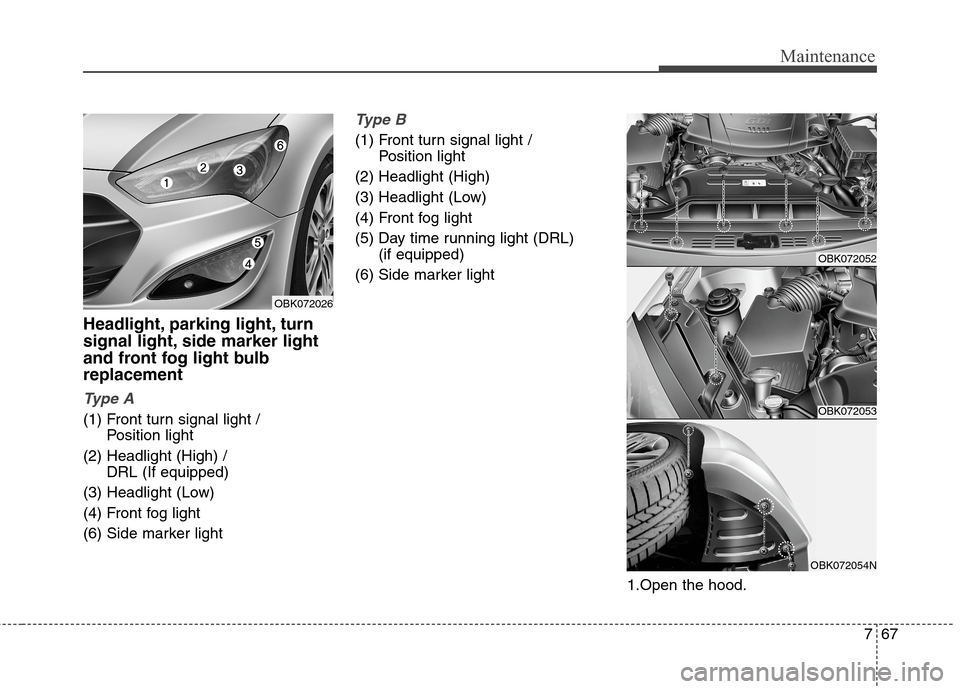
767
Maintenance
Headlight, parking light, turn
signal light, side marker light
and front fog light bulb
replacement
Ty p e A
(1) Front turn signal light /
Position light
(2) Headlight (High) /
DRL (If equipped)
(3) Headlight (Low)
(4) Front fog light
(6) Side marker light
Type B
(1) Front turn signal light /
Position light
(2) Headlight (High)
(3) Headlight (Low)
(4) Front fog light
(5) Day time running light (DRL)
(if equipped)
(6) Side marker light
1.Open the hood.
OBK072052
OBK072053
OBK072054N
OBK072026
Page 403 of 438
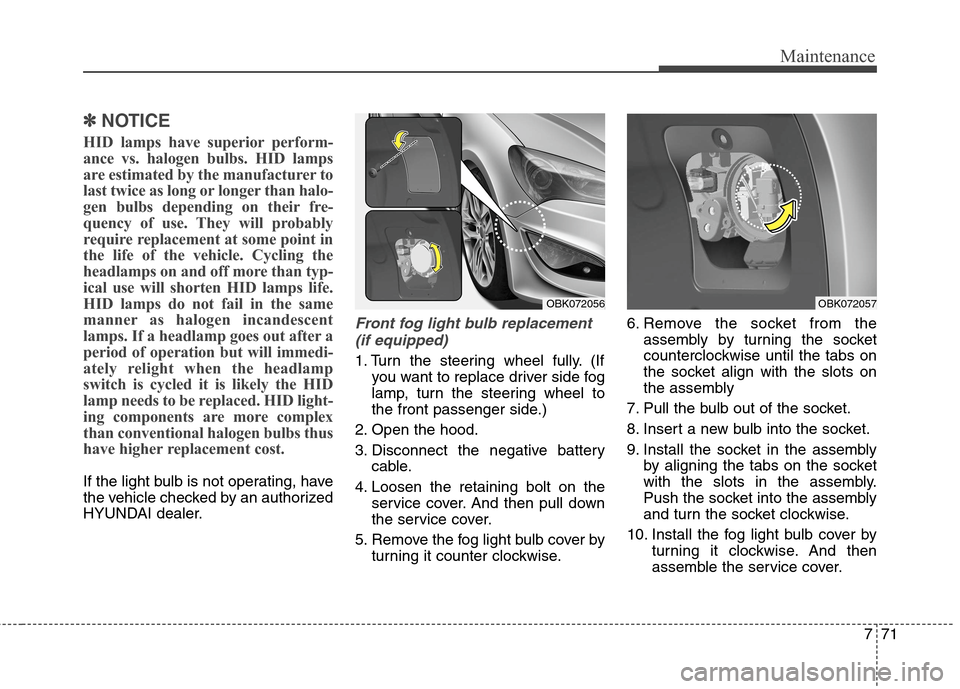
771
Maintenance
✽ ✽
NOTICE
HID lamps have superior perform-
ance vs. halogen bulbs. HID lamps
are estimated by the manufacturer to
last twice as long or longer than halo-
gen bulbs depending on their fre-
quency of use. They will probably
require replacement at some point in
the life of the vehicle. Cycling the
headlamps on and off more than typ-
ical use will shorten HID lamps life.
HID lamps do not fail in the same
manner as halogen incandescent
lamps. If a headlamp goes out after a
period of operation but will immedi-
ately relight when the headlamp
switch is cycled it is likely the HID
lamp needs to be replaced. HID light-
ing components are more complex
than conventional halogen bulbs thus
have higher replacement cost.
If the light bulb is not operating, have
the vehicle checked by an authorized
HYUNDAI dealer.
Front fog light bulb replacement
(if equipped)
1. Turn the steering wheel fully. (If
you want to replace driver side fog
lamp, turn the steering wheel to
the front passenger side.)
2. Open the hood.
3. Disconnect the negative battery
cable.
4. Loosen the retaining bolt on the
service cover. And then pull down
the service cover.
5. Remove the fog light bulb cover by
turning it counter clockwise.6. Remove the socket from the
assembly by turning the socket
counterclockwise until the tabs on
the socket align with the slots on
the assembly
7. Pull the bulb out of the socket.
8. Insert a new bulb into the socket.
9. Install the socket in the assembly
by aligning the tabs on the socket
with the slots in the assembly.
Push the socket into the assembly
and turn the socket clockwise.
10. Install the fog light bulb cover by
turning it clockwise. And then
assemble the service cover.
OBK072056OBK072057